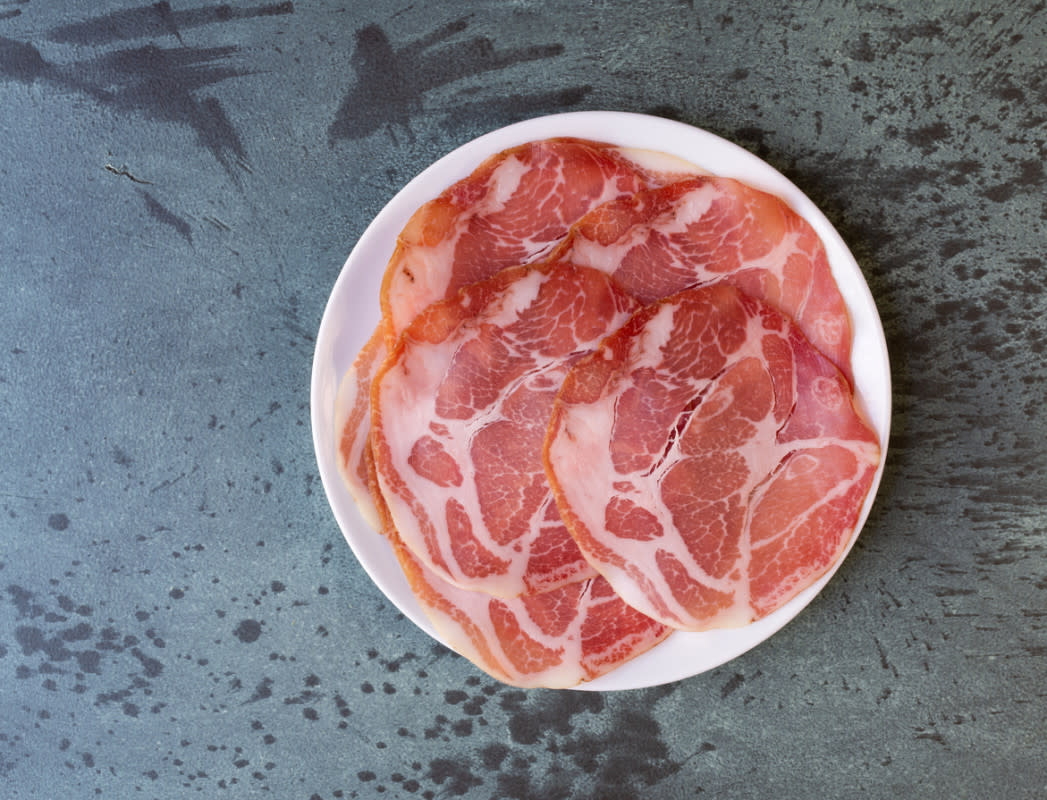What is Gabagool and Why is Tony Soprano So Obsessed With It?

James Gandolfini and cured meats
2024 is the 25th anniversary of The Sopranos and also the year of the mob wife aesthetic. Coincidence? We think not. And if you're making your way through the series for the first (or hundredth) time, you might notice that a certain word comes up an awful lot: gabagool. Tony Soprano utters the word many many times, as do his Italian American co-stars. All this chatter got us curious, so we dug in to find out exactly what gabagool is and what you need to know about it.
Related: 30 Italian Recipes Are Good For Any Night of the Week

iStock
What is Gabagool?
According to Joe Stracci, part-time salami slinger at Marbled Meat Shop in Cold Spring, gabagool is another name for capicola, an Italian cured meat that combines the Italian words for head (capo) and neck (collo). Capicola is made using a prime cut of pork from the neck and shoulder. The recipes for gabagool (aka capicola) vary, but the general process involves seasoning the meat and then curing for up to six months.
Most of the time, gabagool isn't spicy, though that depends on the seasoning ingredients that are used. Because it isn't aged for a long time, it has a tender texture. Some people compare gabagool to prosciutto, but prosciutto is made from pork leg and is aged for longer, giving it a different flavor and texture.
Related: 27 Traditional Italian Recipes
So How Did Capicola Turn Into Gabagool?
According a brilliant story in Atlas Obscura it's all about linguistics. The author notes that about 80% of Italian Americans descended from Southern Italy, where there are a number of different dialectics.
As time and generations went on, and people tried to understand each other, "there is a mangling of the language in an instantly identifiable way: Final syllables are deleted, certain consonants are swapped with others, certain vowels are mutated in certain places." This is how mozzarella becomes something like mutzadell, ricotta becomes ree-goat and prosciutto becomes pruh-zhoot.
Stracci explains it like this: "I do know that the history of Italian words having the ending vowel sounds chopped off in the pronunciation is a mixture of two things: First, regional Italian dialects. I was told as a kid that a Sicilian could hardly understand a Neapolitan because their dialects were so different. The second aspect was when Italians immigrated to the US, usually in New York, to make their foreign words easier to understand and say, they shortened them out of convenience so others would be more open to accepting them, pronouncing them, and the practice stuck. Madonn!"
Stracci says he grew up calling capicola gabagool but "the 'gah' sound at the beginning was not as prevalent in his neighborhood. "There was more of a hint of a “cah” sound. The “buhgool” was there, though," he says.
To see (and hear) the pronunciation by Staten Island residents, check out this video.
How Do You Eat Gabagool (or Capicola)?
Stracci, who grew up snacking on capicola from cold “antipast” platters (See? Chop off the final vowel sound yet again!) found at celebrations like birthday parties, or Christmas Eve, or a graduation, says "a slice of capicola pairs well with a chunk of sharp provolone, a piece of roasted red pepper, and a hunk of fresh seeded Italian bread." And adds that "you should be standing when you eat it."
Jeff Silverstein, co-owner Kitchen Sink Supper Club / Meyers Olde Dutch in Beacon, NY and who is a big fan of capicola says his favorite way to pair it is with some aged parm, fresh baked foccacia, roasted red peppers and olive oil."
Silverstein enjoys a capicola/gabagool seasoned with coriander and fennel and black pepper, though he notes that recipes can vary.
Whether you call it capicola or gabagool, you should definitely add this tasty cured meat to your next charcuterie board or layer it on a sandwich, while definitely channeling your favorite Soprano's character and saying "Gahbahhool?! Over here!”
Related: No Store-Bought Panettone is as Good as My Sicilian Grandma's 50+ Year-Old Recipe
Where Can You Buy Gabagool?
If you're outside of the New York metro area, keep in mind that you might need to say capicola when you're shopping. Gabagool (or capicola) is most readily available at Italian markets, but you can also find it online and at some supermarkets.
Up next: Beyond California Rolls—Everything You Need to Know About Imitation Crab






